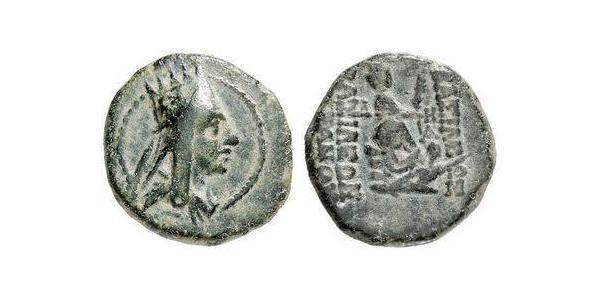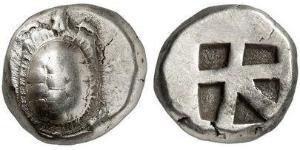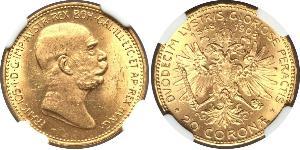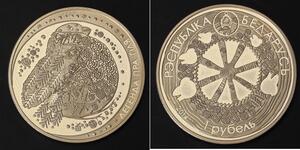[ 5908] TIGRANES IV, the GREAT, 95-65 B.C. Bronze Chalkos (5.35 gm.) Tigranocert, 70-55 B.C. Reference: Depeyrot Armenia p.147 # 43. Nercessian 49. Alram 221. King's head with Armenian tiara right. [ΒAΣIΛEΩC / ΒAΣIΛΕΩN] TIΓPANOY. Tyche of Antioch with palm leaf sitting on rock, Orontes at her feet to the right, the H and A, Δ to the left field. Provided with certificate of authenticity. CERTIFIED AUTHENTIC by Sergey Nechayev, PhD - Numismatic Expert Tigranes IV (flourished 1st century BC, died about 2 BC) was a Prince of Armenian, Greek and Persian descent who served as a Roman Client King of Artaxiad Armenia from 10 BC until 2 BC. Tigranes IV was the son born to Tigranes III by an unnamed mother. His known sibling was his younger paternal half-sister Erato who was born to another unnamed woman.[4] Although Tigranes IV was the namesake of his father, the name Tigranes was the most common royal name in the Artaxiad Dynasty and was among the most ancient names of the Armenian Kings.[5] Tigranes IV was born and raised either in Rome where his father lived in political exile for 10 years[6] from 30 BC until 20 BC or during his father’s Kingship of Armenia in which he ruled from 20 BC until 10 BC. Tigranes III died before 6 BC. In 10 BC, the Armenians installed Tigranes IV as King as the successor to his father.[9] In accordance with Oriental custom or Hellenistic custom, Tigranes IV married his sister Erato in order to preserve the purity of the Artaxiad Royal blood line. Erato through marriage to her brother, became Queen[11] and his Queen consort.[12] From their sibling union at an unknown date, Erato bore Tigranes IV an unnamed daughter who later married King Pharasmanes I of Iberia who ruled from 1 until 58 by whom had three sons: Mithridates I of Iberia, Rhadamistus and Amazaspus (Amazasp) who is known from a Greek inscription found in Rome. Although Tigranes IV and Erato were Roman Client Monarchs governing Armenia, they were both anti Roman and were not the choices of the Roman emperor Augustus for the Armenian throne, as their duel rule did not have Roman approval and they leaned towards Parthia for support. Rome and Parthia competed with one another for their protégés to have influence and govern Armenia.[16] Roman Historian of the 4th century, Sextus Rufus informs us that anti-Roman sentiment was building in Armenia during the reign of Tigranes IV and Erato. Rufus also emphasizes that the Kingdom of Armenia was very strong during this period. The dispossessed and the discontent of the ruling Artaxiad monarchs and their subjects towards Ancient Rome had instigated war with the aid of King Phraates V of Parthia. To avoid a full scale war with Rome, Phraates V soon ceased his support to the Armenian ruling Monarchs. This lead Tigranes IV and Erato, acknowledging Roman suzerainty;[17] sending their good wishes and submission to Rome. Augustus receiving their submission to Rome and good wishes, allowed them to remain in power. Tigranes IV issued bronze coins with portraits of himself with Augustus with the inscription in Greek βασιλεύς μέγας νέος Τιγράνης (of great new king Tigranes), also issued coins shared by Erato with the inscription in Greek Έρατω βασιλέως Τιγράνου άδελφή (Erato, sister of King Tigranes).[20] Other coinage Tigranes IV and Erato issued together, is a portrait of Tigranes IV heavily bearded with Erato with the Greek legend great king, Tigranes. Sometime about 2 BC Tigranes IV was killed in battle, perhaps ending an internal Armenian revolt[23] of those who were infuriated by the royal couple becoming allies to Rome. The war and the chaos that occurred afterwards, Erato abdicated her throne and ended her rule over Armenia. From the situation surrounding Tigranes IV and Erato, the Armenians requested to Augustus, a new Armenian King.[25] Augustus found and appointed Ariobarzanes as the new King of Armenia[26] in 2 BC. Ariobarzanes through his father was a distant relative ...
voir plus
Similar Coin Groups
2025-05-23
-
Nouvelles pièces
Nouvelles pièces de
Save seller - sloveniacoins
.
Une d'entre elle est
Une d'entre elle est
BENIN 1500 Francs / 1 Africa 2005 - European Union - aUNC - 2794 *
2025-05-30
-
Nouvelles pièces
Nouvelles pièces de
Save seller - sloveniacoins
.
Une d'entre elle est
Une d'entre elle est
BELARUS 1 Rouble 2014 Proofike - Copper/Nickel - Legend of the Bullfinch - 2699
Vous pourriez être intéressé par...






















